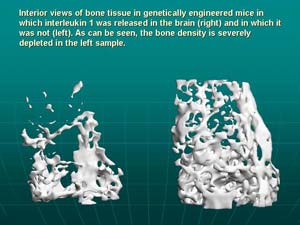Brain plays key role in regulating bone density

The brain plays an important role in the maintenance of proper bone density, researchers at the Hebrew University of Jerusalem have revealed.
The results of this research, involving a study of the activity of the protein interleukin 1 in the brain, comprise not only a breakthrough in understanding the regulation of bone density by the brain but also hold promise for the development of future treatment for osteoporosis, say the researchers. An article about their work appears in the current online edition of the prestigious American journal, Proceedings of the National Academy of Sciences.
The Hebrew University research project is headed by Prof. Itai Bab of the Bone Laboratory, working in cooperation with Prof. Raz Yirmiya of the Department of Psychology, Prof. Esther Shahami of the of the Laboratory for the Study of Brain Trauma, Ph.D. students Alon Bagin and Inbal Goshen and master’s degree student Sharon Feldman.
Osteoporosis is the most widespread, degenerative disease in the Western world. It is characterized by loss of bone density and consequent structural weakening of the skeleton. Osteoporosis sufferers are highly susceptible to fractures, in some cases leading to severe physical disability and complications that can even end in death.
In humans and other vertebrates, one-tenth of the bone tissue is involved in an “exchange” process of continuous bone loss and generation. In adult humans and other mammals, this process is balanced; that is, the amount of bone tissue that is generated is equal to that which is lost, thus preserving bone density. With age, this balance is disrupted, and the amount of bone tissue that is lost is greater than that which is created, with the result that bone density declines and bone structure is impaired.
The interleukin 1 protein has been known for many years as a stimulator of the immune system. In the skeleton the protein causes an increase in the number and activity of osteoclastic cells – the cells which break down bone tissue and which develop from the same cells as those of the immune system.
By experimenting with genetically engineered laboratory mice whose ability to react to interleukin 1 was controlled, the Hebrew University researchers were able to demonstrate that the proper loss/generation balance in bone tissue is regulated by the level of activity of interleukin 1 in the brain. A normal, optimal level of interleukin 1 activity in the brain is required to protect bone density by impeding bone tissue breakdown, say the scientists.
“The connection between the brain and the bone structure is a new area of research about which very little is known,” said Prof Bab. “These new findings from our laboratories at the Hebrew University regarding the action of interleukin 1 on the breakdown of bone tissue indicate a complex neural system controlling bone structure and point the way towards new revelations in the near future in this area.”
The research was conducted within the framework of a project directed at clarifying the connection between the brain, behavior and changes in skeletal structure. The research was funded by the Bikura [First] Program of the Israel Science Foundation, which supports pioneering, innovative, interdisciplinary initiatives.
Media Contact
More Information:
http://www.huji.ac.ilAll latest news from the category: Life Sciences and Chemistry
Articles and reports from the Life Sciences and chemistry area deal with applied and basic research into modern biology, chemistry and human medicine.
Valuable information can be found on a range of life sciences fields including bacteriology, biochemistry, bionics, bioinformatics, biophysics, biotechnology, genetics, geobotany, human biology, marine biology, microbiology, molecular biology, cellular biology, zoology, bioinorganic chemistry, microchemistry and environmental chemistry.
Newest articles

Peptides on Interstellar Ice
A research team led by Dr Serge Krasnokutski from the Astrophysics Laboratory at the Max Planck Institute for Astronomy at the University of Jena had already demonstrated that simple peptides…

A new look at the consequences of light pollution
GAME 2024 begins its experiments in eight countries. Can artificial light at night harm marine algae and impair their important functions for coastal ecosystems? This year’s project of the training…

Silicon Carbide Innovation Alliance to drive industrial-scale semiconductor work
Known for its ability to withstand extreme environments and high voltages, silicon carbide (SiC) is a semiconducting material made up of silicon and carbon atoms arranged into crystals that is…





















